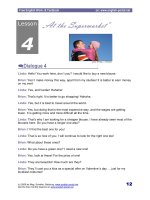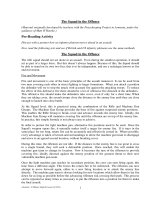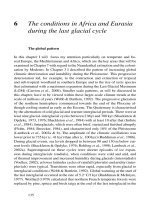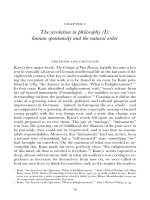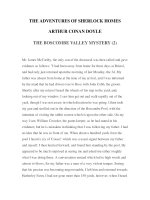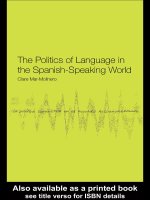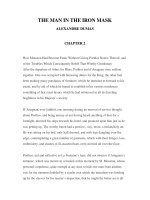4 2 the spanish in florida
Bạn đang xem bản rút gọn của tài liệu. Xem và tải ngay bản đầy đủ của tài liệu tại đây (2.97 MB, 10 trang )
Fascinating Facts
• The real name of the pirate Blackbeard, who
The Spanish
in Florida
attacked Spanish ships along the Florida coast,
was Edward Teach (or Thatch).
• Even though St. Augustine was a colony founded
by Spanish settlers in 1565, no king or queen of
Spain visited it until April 1, 2001—almost 436
years later!
• Juan Alonso Cabale, whose ancestors were
Spanish settlers and Timucua Indians, was
the last person who could speak the Timucua
language. He died in 1767.
Genre
Nonfiction
Comprehension Skill
Compare and
Contrast
Text Features
• Maps
• Time Line
• Captions
Scott Foresman Social Studies
ISBN 0-328-14873-3
ì<(sk$m)=beihdi< +^-Ä-U-Ä-U
by Ellen Cutler
This book is about St. Augustine, Florida.
St. Augustine is the oldest town in the
United States of America that was built
by settlers from Europe. Settlers from
Spain built this town around a Native
American village.
Write to It!
The names of places have special meanings.
“Florida,” for example, means “flowery
place.” What is the name of your town, or
state, or a park, river, or mountain near
where you live? Where did that name come
from? Write a paragraph about your place.
Explain what its name means and where it
comes from.
The Spanish
in Florida
Vocabulary
empire
expedition
colony
Write your paragraph on a separate sheet
of paper.
thatch
culture
criollo
mission
missionaries
convert
Maps
by Ellen Cutler
3, 5, 14 MapQuest, Inc.
Photographs
Every effort has been made to secure permission and provide appropriate credit for photographic material. The publisher deeply
regrets any omission and pledges to correct errors called to its attention in subsequent editions.
Unless otherwise acknowledged, all photographs are the property of Scott Foresman, a division of Pearson Education.
Photo locators denoted as follows: Top (T), Center (C), Bottom (B), Left (L), Right (R) Background (Bkgd)
ISBN: 0-328-14873-3
Copyright © Pearson Education, Inc. All Rights Reserved. Printed in the
United States of America. This publication or parts thereof, may be used with appropriate
equipment to reproduce copies for classroom use only.
1 2 3 4 5 6 7 8 9 10 V0G1 14 13 12 11 10 09 08 07 06 05
Opener: Nik Wheeler/Corbis
4 (C1) The Granger Collection, (C2) Image Farm, Inc.
8 The Granger Collection Editorial Offices: Glenview, Illinois • Parsippany, New Jersey • New York, New York
9 Library of Congress, Washington D.C., USA/Bridgeman Art Library
11 The Granger Collection,Sales
NY Offices: Needham, Massachusetts • Duluth, Georgia • Glenview, Illinois
12 Timothy O`Keefe/IndexCoppell,
Stock Imagery
Texas • Sacramento, California • Mesa, Arizona
13 Richard Cummins/Corbis
15 ©N. Carter/North Wind Picture Archives
The Spanish Arrive
in Florida
Spain was the first country in Europe to make
America part of its empire.
In 1492 Christopher Columbus set sail from
Spain across the Atlantic Ocean. He was headed
for India. When he landed in the islands southeast
of Florida, he was sure he had arrived in India. He
called the people he found “Indians” and claimed
the islands in the name of the king and queen of
Spain.
Other explorers followed Columbus. They sailed
farther and found a huge land beyond the islands,
which they added to the Spanish Empire.
Juan Ponce de León, another explorer sent by
Spain, gave Florida its name. In 1513 Ponce de
León sailed his ship through the Atlantic Ocean and
past tiny islands and beautiful beaches. He brought
his expedition ashore at a place filled with sweetsmelling flowers. He named the land “la Florida.”
La Florida is Spanish for “flowery place.”
EUROPE
N
SPAIN
N O RT H
AMERICA
Palos
Canary
Islands
Bahama
Islands
Cuba
AFRICA
San Salvador
Island
ATLANTIC OCEAN
Key
Hispaniola
Caribbean Sea
0
0
500
500
1,000 Miles
1,000 Kilometers
SOUTH AMERICA
2
3
Columbus’s
first voyage,
1492–1493
ALABAMA
GEORGIA
ATLANTIC
OCEAN
Pensacola
The area that Ponce de León named “la Florida”
was much larger than the state of Florida is today.
It covered several states from the Mississippi River
to the Atlantic Ocean.
San Luis
N
San Mateo
Castillo de
San Marcos
St. Augustine
Cape
Canaveral
Gulf of Mexico
Tampa Bay
Lake
Okeechobee
Charlotte Harbor
0
0
75
75
150 Miles
Biscayne
Bay
150 Kilometers
The Founding of
St. Augustine
Juan Ponce de León
In 1521 Ponce de León returned to Florida and
tried to start a colony. Life was hard, and Native
Americans attacked the settlers, forcing Ponce de
León and his crew to leave. Other Spanish explorers
founded colonies too, but none of them was a
success.
4
Other European countries followed Spain to
America’s shores. France, Holland, and England all
sent expeditions to explore the country and claim its
land.
When France built a colony on the northeastern
coast of Florida in 1564, Spain was determined to
destroy it.
The king of Spain sent Pedro Menéndez de Avilés
to drive the French out and colonize the area.
5
In 1565 Menéndez’s troops battled the French
and won. Menéndez named the place where he set
up camp St. Augustine. He also brought settlers to
live there.
Most of the colonists were men. Only a few were
women and some were enslaved Africans.
Life in St. Augustine was dangerous and difficult.
The colonists feared the Native Americans and soon
moved to a nearby island where they could feel
safe. Only the soldiers stayed behind.
The townspeople came back to St. Augustine in
1572, but life remained hard. St. Augustine was
destroyed by fire several times and suffered through
many storms. Some of the worst hurricanes came in
1599, 1638, 1674, and 1707.
Dates in the History of Florida
and St. Augustine
1845
Florida becomes
the 27th state in
the United States of
America.
1492
Christopher Columbus
arrives in islands near
Florida.
1513
1565
1740
Menéndez founds
St. Augustine
and destroys the
French colony.
British settlers
in the colony of
Georgia attack
St. Augustine.
1783
Spain takes
back control of
Florida after the
American War for
Independence.
Ponce de León
claims new land for
Spain and names it
“la Florida.”
1490
1530
1570
1610
1650
1690
1730
1770
1810
1850
1577
1564
Missionaries arrive in
large numbers in Florida to
convert Native Americans to
Christianity.
France founds a colony on the
northeastern coast of Florida.
6
1763
1821
Spain loses Florida
to Great Britain.
Spain gives
Florida to the
United States.
7
The Timucua Indians
When Menéndez landed in Florida, he was
welcomed by the Timucua Indians. The Timucua
had lived in the area for more than five hundred
years.
Timucua homes were round huts made from
thatch. The largest building in the village was the
council house, where meetings were held. It was in
the center of the village. Each family had its own
home, but the whole community cooked and ate
together.
This was one of the
first pictures made
of Native Americans
in North America.
8
Timucua men had long hair, which they tied in a
knot on top of their heads. They hunted bears, deer,
wild turkey, and alligators with spears, clubs, and
bows and arrows. They also made dugout canoes
from the trunks of large trees.
The women grew corn, beans, and squash. They
also gathered roots, berries, and nuts. They sewed
clothes and shaped cooking pots from clay they dug
from the ground.
9
The Timucua and
the Colonists
In 1565 the Timucua chief of the area around
St. Augustine was named Seloy. He invited
Menéndez and his troops to stay in his village and
even welcomed the settlers. His people gave the
newcomers food and showed them how to build
thatch houses.
When the settlers took over the village, however,
the Timucua defended their land. They attacked the
Spanish fort, setting it on fire with burning arrows.
The coming of the Europeans changed the world
the Timucua and other Native Americans had known.
The colonists often treated them badly and forced
them to do heavy work. With the arrival of the
settlers also came diseases that killed many Native
Americans.
10
English ships attack and destroy St. Augustine.
Daily Life in Spanish
St. Augustine
St. Augustine was a small town. It was also a
poor town. There were no large farms, goldmines,
or forests full of trees.
The colonists faced floods, fires, hurricanes,
disease, and unfriendly Native Americans. Often
there was not enough food.
Still, St. Augustine was important to the Spanish
Empire. Ships full of treasure on their way back to
Spain could hide from storms and pirates. Soldiers
living in the fort could defend Florida from the
English.
11
The People of St. Augustine
The culture of St. Augustine was very much like
Spain’s culture. The colonists followed the Catholic
religion and obeyed Spanish laws. Even the
buildings were built in the Spanish style.
The people with the most power in St. Augustine
were the peninsulars (peh-NIN-seh-lehrs). Peninsulars
were born in Spain but lived in America. They were
called peninsulars because Spain, like Florida, is a
peninsula.
Next came the criollos (cree-OH-yohs). A criollo
had Spanish-born parents but was born in Florida.
The peninsulars and criollos in the rich and upper
classes held tightly to the culture of Old Spain.
12
Poor people, like soldiers and workers, had less
power than rich people. Native Americans and
enslaved people had the least amount of power in
the Spanish colonies.
There were many more men than women in the
Spanish colonies. Therefore, soldiers often married
Native American women. These women brought
their traditions and culture with them to the colony.
St. Augustine
soon created a
new culture that
combined Spanish,
Native American,
and African
customs.
13
San
Carlos
ATLANTIC
OCEAN
GEORGIA
Santa
Maria
EE
San
San Lorenzo
Damian APALACHEE de Ibitachuco
San Mateo
San Luis
Santa Elena
San Pedro
de los Chines
San
Miguél
M
UC
UA
Santa Catalina
de Guale
St. Johns Bay
TI
M
UC
San Juan del Puerto
UA
San Juan Guarcára
TI
AP
AL
AC
H
San
Nicolás
San
Pedro
Santa Catalina
Santa Cruz de Tarihica
Apalachee
Santa
Santa
Cruz
de
Ajohica
Bay
Rosa
Santa Fé de Toloca
TI
MU
San Francisco
CU
A
de Potano
Gulf of Mexico
Nombre
de Dios
St. Augustine
San Diego
San Antonio
de Anacape
Tissimi
San Luis de Acuera
Santa Lucia de Acuera
Key
Mission
San Salvador
de Mayaca
San Luis
de Eloquale
Mission trail
Nuestra Señora de
Guadalupe de
Tolomato
Autocuimi
N
APALACHEE
Native American group
TIMUCUA
Native American group
0
Present-day border
0
25
25
50 Miles
50 Kilometers
The Spanish Missions
in Florida
Another event that changed life in Florida in the
1600s was the building of Spanish missions. The
Spanish government sent missionaries as well
as soldiers and settlers to Florida. The goal of the
missionaries was to convert Native Americans
to Christianity. Missionaries founded religious
communities, or missions, that provided housing,
care, and education for the Native Americans. By
1675 a chain of missions stretched across northern
Florida.
14
The End of Spanish
St. Augustine
The English continued to colonize America.
Attacks on Spanish settlements such as St. Augustine
took place more often. Finally Spain gave Florida
to England in return for control over the island of
Cuba.
In 1763, more than 250 years after Ponce de
León claimed “la Florida” for the Spanish Empire,
it became part of the British Empire. St. Augustine
became an English town. The United States took
over Florida in
1821. In 1845,
Florida became
the twentyseventh state.
St. Augustine
became the
oldest European
settlement in the
United States.
15
Glossary
This book is about St. Augustine, Florida.
Write to It!
colony
a settlement
or oldest
town built
St. Augustine
is the
townby
inone
the
country
in States
anotherofcountry
United
America that was built
by settlers
from Europe.
Settlers
from
convert
to change
a person’s
point of
view or
Spain beliefs
built this
around
Native
religious
to atown
different
viewaor
belief
American village.
criollo a person whose ancestors came from
Spain and who was born in one of Spain’s
colonies in NorthVocabulary
or South America
culture the religion,empire
laws, and arts unique to
a group of people expedition
that can be passed down to
their children and grandchildren
colony
empire a government that controls lands far
thatch
beyond the borders of
its country
culture
expedition a group
making a journey for a
The names of places have special meanings.
“Florida,” for example, means “flowery
place.” What is the name of your town, or
state, or a park, river, or mountain near
where you live? Where did that name come
from? Write a paragraph about your place.
Explain what its name means and where it
comes from.
Write your paragraph on a separate sheet
of paper.
criolloan unknown land
purpose, such as exploring
mission
mission a church or
settlement where religion
is taught
missionaries
missionaries people
who go out in the world
convert
to teach a particular religion or set of beliefs
Maps
3, 5, 14 MapQuest, Inc.
Photographs
thatch leaves or other plant material used in
building structures
Every effort has been made to secure permission and provide appropriate credit for photographic material. The publisher deeply
regrets any omission and pledges to correct errors called to its attention in subsequent editions.
Unless otherwise acknowledged, all photographs are the property of Scott Foresman, a division of Pearson Education.
Photo locators denoted as follows: Top (T), Center (C), Bottom (B), Left (L), Right (R) Background (Bkgd)
ISBN: 0-328-14873-3
Copyright © Pearson Education, Inc. All Rights Reserved.
Printed in the
16
United States of America. This publication or parts thereof, may be used with appropriate
equipment to reproduce copies for classroom use only.
1 2 3 4 5 6 7 8 9 10 V0G1 14 13 12 11 10 09 08 07 06 05
Opener: Nik Wheeler/Corbis
4 (C1) The Granger Collection, (C2) Image Farm, Inc.
8 The Granger Collection
9 Library of Congress, Washington D.C., USA/Bridgeman Art Library
11 The Granger Collection, NY
12 Timothy O`Keefe/Index Stock Imagery
13 Richard Cummins/Corbis
15 ©N. Carter/North Wind Picture Archives
